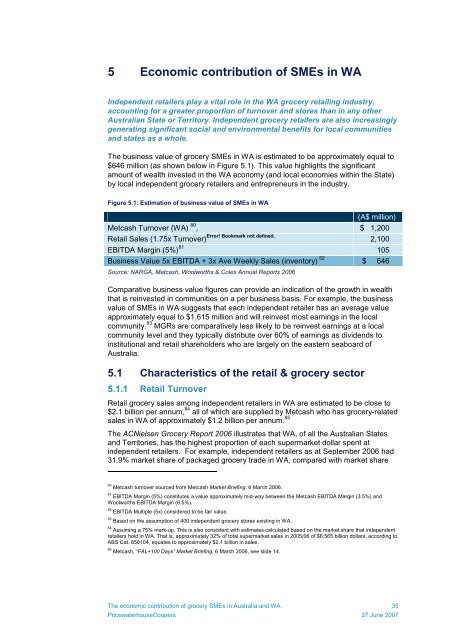The economic contribution of small to medium-sized grocery ...
The economic contribution of small to medium-sized grocery ...
The economic contribution of small to medium-sized grocery ...
Create successful ePaper yourself
Turn your PDF publications into a flip-book with our unique Google optimized e-Paper software.
5 Economic <strong>contribution</strong> <strong>of</strong> SMEs in WA<br />
Independent retailers play a vital role in the WA <strong>grocery</strong> retailing industry,<br />
accounting for a greater proportion <strong>of</strong> turnover and s<strong>to</strong>res than in any other<br />
Australian State or Terri<strong>to</strong>ry. Independent <strong>grocery</strong> retailers are also increasingly<br />
generating significant social and environmental benefits for local communities<br />
and states as a whole.<br />
<strong>The</strong> business value <strong>of</strong> <strong>grocery</strong> SMEs in WA is estimated <strong>to</strong> be approximately equal <strong>to</strong><br />
$646 million (as shown below in Figure 5.1). This value highlights the significant<br />
amount <strong>of</strong> wealth invested in the WA economy (and local economies within the State)<br />
by local independent <strong>grocery</strong> retailers and entrepreneurs in the industry.<br />
Figure 5.1: Estimation <strong>of</strong> business value <strong>of</strong> SMEs in WA<br />
(A$ million)<br />
Metcash Turnover (WA) 80 , $ 1,200<br />
Retail Sales (1.75x Turnover) Error! Bookmark not defined. 2,100<br />
EBITDA Margin (5%) 81 105<br />
Business Value 5x EBITDA + 3x Ave Weekly Sales (inven<strong>to</strong>ry) 82 $ 646<br />
Source: NARGA, Metcash, Woolworths & Coles Annual Reports 2006<br />
Comparative business value figures can provide an indication <strong>of</strong> the growth in wealth<br />
that is reinvested in communities on a per business basis. For example, the business<br />
value <strong>of</strong> SMEs in WA suggests that each independent retailer has an average value<br />
approximately equal <strong>to</strong> $1.615 million and will reinvest most earnings in the local<br />
community. 83 MGRs are comparatively less likely <strong>to</strong> be reinvest earnings at a local<br />
community level and they typically distribute over 60% <strong>of</strong> earnings as dividends <strong>to</strong><br />
institutional and retail shareholders who are largely on the eastern seaboard <strong>of</strong><br />
Australia.<br />
5.1 Characteristics <strong>of</strong> the retail & <strong>grocery</strong> sec<strong>to</strong>r<br />
5.1.1 Retail Turnover<br />
Retail <strong>grocery</strong> sales among independent retailers in WA are estimated <strong>to</strong> be close <strong>to</strong><br />
$2.1 billion per annum, 84 all <strong>of</strong> which are supplied by Metcash who has <strong>grocery</strong>-related<br />
sales in WA <strong>of</strong> approximately $1.2 billion per annum. 85<br />
<strong>The</strong> ACNielsen Grocery Report 2006 illustrates that WA, <strong>of</strong> all the Australian States<br />
and Terri<strong>to</strong>ries, has the highest proportion <strong>of</strong> each supermarket dollar spent at<br />
independent retailers. For example, independent retailers as at September 2006 had<br />
31.9% market share <strong>of</strong> packaged <strong>grocery</strong> trade in WA, compared with market share<br />
80 Metcash turnover sourced from Metcash Market Briefing, 6 March 2006.<br />
81 EBITDA Margin (5%) constitutes a value approximately mid-way between the Metcash EBITDA Margin (3.5%) and<br />
Woolworths EBITDA Margin (6.5%).<br />
82 EBITDA Multiple (5x) considered <strong>to</strong> be fair value.<br />
83 Based on the assumption <strong>of</strong> 400 independent <strong>grocery</strong> s<strong>to</strong>res existing in WA.<br />
84 Assuming a 75% mark-up. This is also consistent with estimates calculated based on the market share that independent<br />
retailers hold in WA. That is, approximately 32% <strong>of</strong> <strong>to</strong>tal supermarket sales in 2005/06 <strong>of</strong> $6.565 billion dollars, according <strong>to</strong><br />
ABS Cat. 850104, equates <strong>to</strong> approximately $2.1 billion in sales.<br />
85 Metcash, “FAL+100 Days” Market Briefing, 6 March 2006, see slide 14.<br />
<strong>The</strong> <strong>economic</strong> <strong>contribution</strong> <strong>of</strong> <strong>grocery</strong> SMEs in Australia and WA 35<br />
PricewaterhouseCoopers 27 June 2007

















